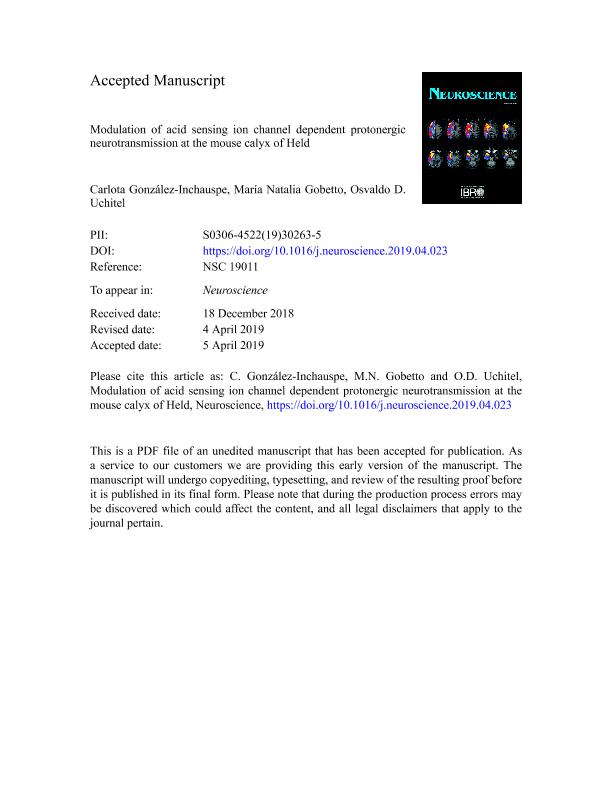Mostrar el registro sencillo del ítem
dc.contributor.author
González Inchauspe, Carlota María Fabiola

dc.contributor.author
Gobetto, María Natalia

dc.contributor.author
Uchitel, Osvaldo Daniel

dc.date.available
2020-12-28T17:03:28Z
dc.date.issued
2020-07
dc.identifier.citation
González Inchauspe, Carlota María Fabiola; Gobetto, María Natalia; Uchitel, Osvaldo Daniel; Modulation of acid sensing ion channel dependent protonergic neurotransmission at the mouse calyx of Held; Pergamon-Elsevier Science Ltd; Neuroscience; 439; 7-2020; 195-210
dc.identifier.issn
0306-4522
dc.identifier.uri
http://hdl.handle.net/11336/121240
dc.description.abstract
Acid-sensing ion channels (ASICs) regulate synaptic activities and play important roles in neurodegenerative diseases. It has been reported that homomeric ASIC-1a channels are expressed in neurons of the medial nucleus of the trapezoid body (MNTB) of the auditory system in the CNS. During synaptic transmission, acidification of the synaptic cleft presumably due to the co-release of neurotransmitter and H+ from synaptic vesicles activates postsynaptic ASIC-1a channels in mice up to 3 weeks old. This generates synaptic currents (ASIC1a-SCs) that add to the glutamatergic excitatory postsynaptic currents (EPSCs). Here we report that neuromodulators like histamine and natural products like lactate and spermine potentiate ASIC1a-SCs in an additive form such that excitatory ASIC synaptic currents as well as the associated calcium influx become significantly large and physiologically relevant. We show that ASIC1a-SCs enhanced by endogenous neuromodulators are capable of supporting synaptic transmission in the absence of glutamatergic EPSCs. Furthermore, at high frequency stimulation (HFS), ASIC1a-SCs contribute to diminish short term depression (STD) and their contribution is even more relevant at early stages of development. Since ASIC channels are present in almost all type of neurons and synaptic vesicles content is acid, the participation of protons in synaptic transmission and its potentiation by endogenous substances could be a general phenomenon across the central nervous system.
dc.format
application/pdf
dc.language.iso
eng
dc.publisher
Pergamon-Elsevier Science Ltd

dc.rights
info:eu-repo/semantics/openAccess
dc.rights.uri
https://creativecommons.org/licenses/by-nc-nd/2.5/ar/
dc.subject
ACID SENSING ION CHANNEL (ASIC)
dc.subject
CALYX OF HELD
dc.subject
GLUTAMATERGIC SYNAPTIC TRANSMISSION
dc.subject
HISTAMINE
dc.subject
PROTONS
dc.subject
SYNAPTIC PLASTICITY
dc.subject.classification
Neurociencias

dc.subject.classification
Medicina Básica

dc.subject.classification
CIENCIAS MÉDICAS Y DE LA SALUD

dc.title
Modulation of acid sensing ion channel dependent protonergic neurotransmission at the mouse calyx of Held
dc.type
info:eu-repo/semantics/article
dc.type
info:ar-repo/semantics/artículo
dc.type
info:eu-repo/semantics/publishedVersion
dc.date.updated
2020-11-13T20:44:52Z
dc.journal.volume
439
dc.journal.pagination
195-210
dc.journal.pais
Estados Unidos

dc.description.fil
Fil: González Inchauspe, Carlota María Fabiola. Consejo Nacional de Investigaciones Científicas y Técnicas. Oficina de Coordinación Administrativa Ciudad Universitaria. Instituto de Fisiología, Biología Molecular y Neurociencias. Universidad de Buenos Aires. Facultad de Ciencias Exactas y Naturales. Instituto de Fisiología, Biología Molecular y Neurociencias; Argentina
dc.description.fil
Fil: Gobetto, María Natalia. Consejo Nacional de Investigaciones Científicas y Técnicas. Oficina de Coordinación Administrativa Ciudad Universitaria. Instituto de Fisiología, Biología Molecular y Neurociencias. Universidad de Buenos Aires. Facultad de Ciencias Exactas y Naturales. Instituto de Fisiología, Biología Molecular y Neurociencias; Argentina
dc.description.fil
Fil: Uchitel, Osvaldo Daniel. Consejo Nacional de Investigaciones Científicas y Técnicas. Oficina de Coordinación Administrativa Ciudad Universitaria. Instituto de Fisiología, Biología Molecular y Neurociencias. Universidad de Buenos Aires. Facultad de Ciencias Exactas y Naturales. Instituto de Fisiología, Biología Molecular y Neurociencias; Argentina
dc.journal.title
Neuroscience

dc.relation.alternativeid
info:eu-repo/semantics/altIdentifier/doi/http://dx.doi.org/10.1016/j.neuroscience.2019.04.023
dc.relation.alternativeid
info:eu-repo/semantics/altIdentifier/url/https://www.sciencedirect.com/science/article/abs/pii/S0306452219302635
Archivos asociados
